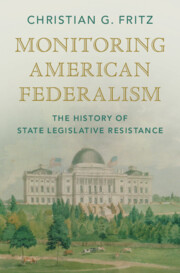Book contents
- Monitoring American Federalism
- Studies in Legal History
- Monitoring American Federalism
- Copyright page
- Dedication
- Contents
- Acknowledgments
- Introduction
- 1 The Riddle of Federalism and the Genesis of Interposition
- 2 Early State Use of Interposition: Testing the Powers of the New National Government
- 3 State Interposition and Debates over the Meaning of the Constitution
- 4 The Virginia and Kentucky Resolutions and Madison’s Report of 1800
- 5 State Interposition during the Jefferson and Madison Presidencies
- 6 State Challenges to the Supreme Court’s Control over Constitutional Interpretation
- 7 The Transformation of Interposition: The Theory of Nullification Emerges
- 8 State Interposition and Nullification on the Path to Secession
- 9 State Interposition during and after the Civil War
- 10 Modern Interposition by States and “Nullification”
- Abbreviations
- Notes
- Selected Short Titles
- Index
2 - Early State Use of Interposition: Testing the Powers of the New National Government
Published online by Cambridge University Press: 05 January 2023
- Monitoring American Federalism
- Studies in Legal History
- Monitoring American Federalism
- Copyright page
- Dedication
- Contents
- Acknowledgments
- Introduction
- 1 The Riddle of Federalism and the Genesis of Interposition
- 2 Early State Use of Interposition: Testing the Powers of the New National Government
- 3 State Interposition and Debates over the Meaning of the Constitution
- 4 The Virginia and Kentucky Resolutions and Madison’s Report of 1800
- 5 State Interposition during the Jefferson and Madison Presidencies
- 6 State Challenges to the Supreme Court’s Control over Constitutional Interpretation
- 7 The Transformation of Interposition: The Theory of Nullification Emerges
- 8 State Interposition and Nullification on the Path to Secession
- 9 State Interposition during and after the Civil War
- 10 Modern Interposition by States and “Nullification”
- Abbreviations
- Notes
- Selected Short Titles
- Index
Summary
The new Constitution had existed for a short time before Madison and others became concerned about constitutional interpretations that were expanding the power of the national government. This early dialogue about federalism centered on what each state viewed as undesirable equilibrium: either forces that would weaken the relative authority of states or forces that would diminish national authority. Secretary of the Treasury Alexander Hamilton’s financial and economic policies were broad expansions of national powers including assuming Revolutionary War debts and establishing a national bank. Anti-Federalists and others viewed these policies as part of a dangerous trend towards national consolidation that would eventually annihilate the states. Southern states, in particular, thought that without constitutional amendments to constrain the powers of a Northern majority, the South would be unable to protect slavery. When Virginia’s legislature passed the nation’s first interposition resolutions and a memorial in 1790 to sound the alarm to other states and Congress, it faced Federalist criticism that it was illegitimately intruding into the federal government’s sphere.
Keywords
- Type
- Chapter
- Information
- Monitoring American FederalismThe History of State Legislative Resistance, pp. 39 - 65Publisher: Cambridge University PressPrint publication year: 2023

